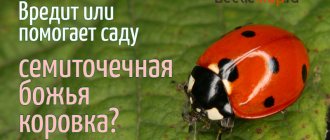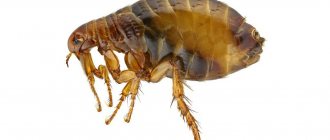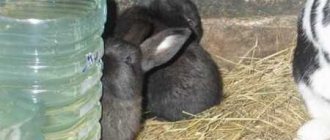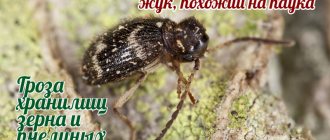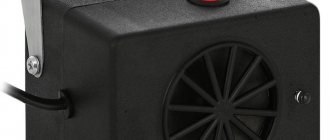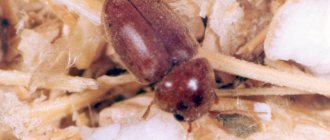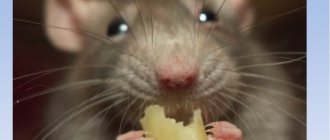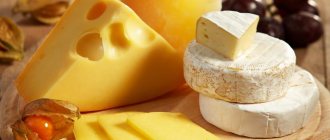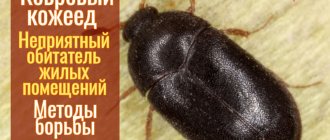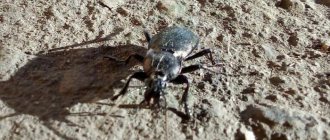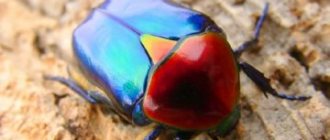The flour beetle is a small heat-loving insect that is a malicious pest of flour, grain, nuts, dried fruits and other food supplies. This pest can parasitize in large granaries, bakeries, shops and in residential buildings and apartments. In our country, it is widespread, and in the southern regions the parasite lives in any premises, and in the northern regions - only in heated ones.
Meet the Beetle
The mukoed belongs to a large group of household parasites (class of flat beetles of the Coleoptera order). Its flattened and long body is tiny, barely reaching 2.5-3.5 mm in length. The chitinous shell is brown in color with different shades - from darkish to lightish. The bug has small antennae and a flattened head.
The mukoeater has well-developed wings, this parasite flies well and leads an active lifestyle.
The mucoed is an insect that prefers warmth. It begins to multiply rapidly at temperature parameters of +25-27⁰C with a humidity of about 65%. In favorable places, 35-40 days are enough for the bug to fully develop. When the temperature drops to +16⁰C, the beetle stops reproducing, and at 0⁰C and below it quickly dies.
Why is it dangerous?
The pest poses the greatest threat to food supplies (flour/grain/nuts). The parasite does not disdain vegetable warehouses and stocks of dried fruits. This pest is voracious and can quickly destroy almost all stocks. The mucoed is also distinguished by its high fertility. A female beetle lays up to 500-700 eggs at a time. The masonry is made on the food components where the individual is currently located.
It is strictly not recommended to consume foods contaminated with mucoid. They are spoiled, completely lose their value and can cause serious allergies.
How the parasite gets into homes
The mucoed is a native of the wild, where its habitat is rotten stumps and tree bark.
But in natural conditions, the bug does not live long - at the first convenient opportunity, it moves to more favorable conditions for it - feed factories, bakeries, mill buildings, barns, etc. The flour beetle makes its way into our homes in several ways:
- from markets in bags (bags) with flour or various cereals;
- in packages with food for four-legged pets (they are usually found in food of poor quality);
- independently, by flight, if the houses are located near enterprises.
When this bug is first detected, it is necessary to take active measures to destroy it. A mucoed on its own will not leave its favorite territory, where there are conditions for its residence and reproduction.
Expert opinion
Mityuk Stefania Bogdanovna
It has been observed that flour eaters eat food supplies whose moisture content starts from 14-16%. If the food is dry, the bugs gather in flocks and excrete copious amounts of excrement, thus moistening the food.
Mucoeds have another unusual feature. The bug, as soon as you touch it, immediately tightens its paws and pretends to be dead. Housewives, believing that the insect is dead, sweep it up and throw it in the trash. From there, the mucous crawls out safely after some time and returns to its habitat.
Features of the life activity of the Suriname mucoed
The Suriname flour beetle is a heat-loving insect that is not very resistant to the effects of cold.
If the air temperature drops below -5 degrees, the mucous eater dies within 10-13 days, and if it is 0, after three weeks. As a rule, Surinamese mucoeds live in large colonies and settle near larger insects. The fact is that it is difficult for Suriname beetles to gnaw through the original shell of grains. Therefore, they eat the leftover food that their neighbors left behind. However, sometimes Suriname mucoeds can be primary pests, but then they do not eat all the food and crops.
If there is no food, the colony of bugs may migrate to another location. After all, these insects are highly active.
When exposed to bright light or danger, the Surinamese mucous eater pretends to be dead. But if it is threatened by a weak or equal enemy, the colony can fight back.
It is important to note that these insects in most cases are not picky about food. If they live in a natural habitat (in bark, stones, under foliage), they usually eat small insects, thus becoming predators.
To fully feed, the pest also needs plant food, and not just cereals and grains. The Surinamese mucous eater can eat the following types of foods:
- flour of any kind;
- pasta and spaghetti;
- dried fruits and dried vegetables;
- cookies and confectionery;
- seeds and nuts.
In their natural habitat, insects do not receive the required amount of plant food. It is because of this that their lifespan is shorter than that of beetles from granaries and warehouses.
Areas of residence
The Suriname mucoed is distributed on all continents of our planet, except Antarctica.
It exists, of course, in our country. In the Russian Federation, it inhabits areas with high humidity and elevated temperatures. After all, as mentioned above, the flour eater does not tolerate sudden changes in temperature. It can reproduce only in warm rooms. In China, the Czech Republic, Slovakia and Hungary, the Suriname mucoed is an organism that must be destroyed.
This insect is often found in granaries and mills, bakeries, industrial enterprises and catering establishments, as well as in human homes.
Effective ways to fight
Before you start expelling mucoids from your home and using a certain remedy, it is necessary to carry out preparatory work:
- Clear all cabinets and tables of food.
- Remove dishes and other food items.
- Treat kitchen surfaces (both outside and inside) with a vinegar solution (25 ml of vinegar per liter of water).
- Pour boiling water over the cracks of the cabinets to kill bugs hidden in the chips (carry out this activity if you are sure that the boiling water will not damage the furniture).
- Empty all jars in which bulk products are stored, rinse thoroughly with soapy water, and then scald with boiling water.
- If food supplies were kept in canvas or linen bags, empty them and soak them in a saline solution.
All preliminary events are mandatory. These procedures will stop females from reproducing and destroy egg laying.
After preparation, you should begin the direct destruction and expulsion of mucous beetles from your favorite territories. There are many ways to do this.
Use of insecticides
Chemicals that are unsafe for humans and pets should only be used when there is a large population of bugs.
The following drugs showed the best results in pest control:
All funds are used in the same way. Everything unnecessary is removed from the room intended for treatment (during the sanitation process, the presence of strangers and pets is not allowed there). Then the windows are opened wide, and the products are generously sprayed on the surfaces (internal and external) of all kitchen furniture.
Expert opinion
Mityuk Stefania Bogdanovna
After treatment, the windows are closed and the time interval is maintained (it is indicated in the annotation for the preparations). At the end of the treatment, the room and furniture are thoroughly wet cleaned.
Traditional methods
If there are not too many mucoids yet, then it is better to use safer traditional methods.
The most effective ones include the following:
Garlic and laurel leaves
Parasites cannot tolerate the aroma of these plants. Garlic cloves and bay leaves are placed in bedside tables and kitchen cabinets. Laurel can also be placed in the flour or cereal itself.
Pyrethrum
Biological powder, which contains dried parts of Dalmatian chamomile. It is sold at any pharmacy. The product is scattered in the kitchen furniture (pyrethrum can also be placed in thin linen bags). The period of action of the powder is 1.5-2 weeks. Then it is replaced with a fresh one. For sanitation, two-time treatment with pyrethrum is sufficient.
Traps
You can also remove the mucous eater using simple traps. You can make it yourself from powdered sugar, borax and finely ground cereal. All ingredients are mixed in equal quantities. The mass is laid out on paper sheets inside the kitchen furniture. Flour eaters, attracted by the food, eat the bait and die from components that are poisonous to them.
Regular ready-made adhesive fly tapes also help catch fly eaters. They are carefully released from the packaging and laid out in their habitats. As the sticky layer fills with insects, I throw it away and replace it with new ones.
The greatest effectiveness is shown by the combined use of sticky traps and products with repellent odors. Bugs, running away from the unbearable aroma, will find themselves in set traps.
Is the Suriname mucoed beetle dangerous and why?
The Surinam mucoed is a very voracious and extremely prolific insect that quickly consumes food reserves.
Moreover, this is done not only by adults, but also by their larvae. Everything that mucoeds came into contact with can no longer be consumed for food purposes for the following reasons:
They leave their excrement in the food. It is not possible to completely rid food of the remains of mucoeds. Feces are very often toxic to the human body and can cause severe allergies.
The food may contain clutches of eggs. It will be impossible to completely rinse or somehow clean food from them. Eggs and larvae of insects can cause poisoning.
Mucoeds carry dangerous fungi and bacteria. If a person consumes a contaminated product, it causes intestinal infectious diseases.
Due to the fact that the insect has powerful jaws, it can chew through bags and the protective layer of paper. And because of their small size and elongated body, the bugs crawl into even the smallest cracks and cracks.
Preventive actions
No one is safe from the invasion of the Suriname mucoed. To minimize the occurrence of the ubiquitous household pest, follow a number of simple preventive measures:
- maintain cleanliness in the kitchen;
- store cereals in a tightly closed container;
- dried fruits must be kept in the refrigerator;
- ventilate the kitchen frequently;
- freshly purchased bulk products should be kept in the freezer for 2-3 days before being sent for storage;
- ensure dryness in the kitchen, do not allow moisture to arise;
- periodically conduct a thorough audit of food products;
- Always keep garlic cloves, bay leaves, sprigs of dry chamomile or rosemary in your kitchen furniture;
- Treat kitchen furniture with vinegar solution 1-2 times a month.
Have you ever had to fight a garden flour beetle?
Was the caseNever
Flour-eating bugs are dangerous and destructive parasites. Once infected, food becomes completely unsuitable and dangerous for consumption. Therefore, when this insect first appears, it is necessary to immediately begin to completely expel it from the apartment.
Maliciousness
How dangerous is the Suriname mucoed? First of all, because it is capable of severely damaging large reserves of flour, cereals and grain in a fairly short period of time. In addition, this pest can often be found in dried fruits and vegetables, often in those that are already moldy.
On a note! In just one time, a female mucoed is capable of laying from 100 to 600 eggs. She lays her eggs on a food substrate, which the emerging larvae subsequently feed on!
Flour eater is also dangerous because it reduces the value of contaminated food products to absolute zero. Eating them is highly discouraged, as there is a high probability of an allergic reaction.
Laemophloeus testaceus F.
Placonotus testaceus, Cryptolestes testaceus, Cucujus testaceus
rufous grain beetle
Coleoptera (Beetles) - Coleoptera
The red flour beetle is a small rusty-yellow beetle. The body is covered with hairs. Pest of grain products with high humidity. Inhabitant of mills, bakeries and feed mills.
The author has repeatedly heard how laboratory assistants at grain processing enterprises called all insects similar to the red mulled beetle “saffron milk beetles”, referring primarily to this one, but, as a rule, classifying many small beetles as the red mulled beetle.
In foreign Internet sources, the red mucoed is considered one species with the short-whiskered (red) mucoed; in most domestic sources, the red mucoed is described as a separate species. (Compiled)
Click on photo to enlarge
Development
Imago . Beetles live up to six months and can fast for up to 2.5 months. Over the course of her life, the female lays several dozen eggs on the foods that the beetles feed on.
The eggs hatch into larvae after a few days.
The development of one generation lasts 70-100 days.
During the year, the red mucous can produce up to 3-5 generations. [6]
Abiotic factors . Reduced humidity is poorly tolerated. It develops better at a temperature of 20-23 ° C and in an environment with high humidity.
The red flour beetle does not develop at a temperature of 12-14 °C: at 16-18 °C the first generation lasts up to 106 days, at 20-23 °C - up to 92. Life expectancy without food also depends on temperature and air humidity. At a temperature of 12-14 °C, beetles can live without food for up to 70 days, at 16-18 °C - up to 62 days, at 25-27 °C - up to 20 days.
As the relative air humidity decreases, the duration of fasting shortens and the insect dies faster. [2]
Related species
Oryzaephilus surinamensis L.
Video
Simple and affordable methods will help you cope with pests in the kitchen. To understand the intricacies of their use, watch the presented videos:
https://youtube.com/watch?v=NzJAWDvm5Zw
Young mother, wife and part-time freelancer. Being a lawyer by training, I am accustomed to collecting and providing the most complete and reliable information. Constantly improves in the professional field and strives for personal growth and development.
Found a mistake? Select the text with the mouse and click:
Threads made of gold and silver, which were used to embroider clothes in the old days, are called gimp. To obtain them, the metal wire was pulled for a long time with pliers to the required fineness. This is where the expression “to drag out the rigmarole” came from - “to do long, monotonous work” or “to delay the completion of a task.”
Before removing various stains from clothing, you need to find out how safe the selected solvent is for the fabric itself. It is applied in a small amount to an inconspicuous area of the item from the inside out for 5-10 minutes. If the material retains its structure and color, you can move on to stains.
If your favorite things show the first signs of gestation in the form of untidy pellets, you can get rid of them using a special machine - a shaver. It quickly and effectively shaves off clumps of fabric fibers and returns things to their proper appearance.
Fresh lemon is not only suitable for tea: clean dirt from the surface of an acrylic bath by rubbing with half a cut citrus, or quickly wash the microwave by placing a container of water and lemon slices in it for 8-10 minutes at maximum power. The softened dirt can simply be wiped off with a sponge.
There are special traps to combat moths. The sticky layer with which they are covered contains female pheromones that attract males. By sticking to the trap, they are eliminated from the reproduction process, which leads to a decrease in the moth population.
The dishwasher cleans more than just plates and cups. You can load it with plastic toys, glass lamp shades and even dirty vegetables, such as potatoes, but only without using detergents.
The easiest way to remove scale and carbon deposits from the soleplate of the iron is with table salt. Pour a thick layer of salt onto the paper, heat the iron to maximum and run the iron over the salt bed several times, applying light pressure.
The habit of using an automatic washing machine “sparingly” can lead to the appearance of an unpleasant odor in it. Washing at temperatures below 60℃ and short rinses allow fungi and bacteria from dirty clothes to remain on internal surfaces and actively multiply.
Stretch ceilings made of PVC film can withstand from 70 to 120 liters of water per 1 m2 of their area (depending on the size of the ceiling, the degree of its tension and the quality of the film). So you don’t have to worry about leaks from neighbors above.
>
Types of “unwanted new settlers”
You need to know the enemy by sight! The choice of battle tactics depends on the characteristics of the insect. To get rid of some bugs in the cereal, it is enough to deprive them of their usual living conditions, and they will die. Others are able to survive a nuclear war.
| Image | Type of beetle |
| Bread grinder The insect is red in color, 3 mm in length. He prefers baked goods, but will not refuse tea, buckwheat or rice. Due to their ability to fly, bread borers are difficult to hatch. | |
| Flour bug Dark cinnamon pests 4 mm in length. They settle in all types of flour, oatmeal and semolina. Flour bugs multiply very quickly, laying eggs disguised as white grains. | |
| food moth It looks like a butterfly, it reaches 1 cm in length. Thanks to its dark color and ability to fly, it is easy to camouflage and hide. It reproduces at a rapid pace, laying about 250 eggs per week. The hatched larvae spin a web that makes them easy to spot. Moths eat everything from flour to dried fruits. | |
| Red mucoed Red bug is 2 mm in length. Lives where it is warm and humid. It feeds on spoiled cereals and reproduces up to 7 times a year. Without food and suitable habitat, it dies. | |
| Weevil Black insects reach 5 mm in length. A distinctive feature is a long proboscis. Absolutely unpretentious insects - they eat everything and settle everywhere. They can go without food for a long time. |
Morphology
Imago . Body length 1.5 – 2.5 mm. The beetle is rusty-yellow in color, the body is narrow, covered with silky hairs. The head is almost equal in width to the chest, the antennae are equal in length to the body and are widely spaced to the sides. [6]
Beetles have wings and fly well. [3]
The larvae are cream-colored, covered with long hairs, the tip of the abdomen is reddish, with two hook-shaped outgrowths, the length of the adult larva is up to 4 mm.
The pupa is light yellow or cream in color, the body is wide, with long hairs, and at the posterior end there are two spiny outgrowths. The length of the pupa is 1.5-2 mm. [2]
Extermination of insects in production
The Surinamese flour eater is a frequent visitor to production. All food industry enterprises know how to get rid of this dangerous bug. Most often, flour eaters are poisoned with various chemicals that are used to treat production facilities and the grains themselves. These are insecticides and preparations based on hydrogen fluoride.
If all these conditions are met, bugs will not appear . However, very often the quality department in production does not do its job. In this case, the products are not checked, and cleaning measures may not be carried out at all. Therefore, the bugs breed and move into bags of cereals.
After this, the Surinamese mucoed starts to appear in the apartment. Every housewife should know how to get rid of it once and for all, because an unexpected guest can appear at any moment.
How to get rid of the red mukoeater in the house
On an industrial scale, people fight mucous beetles and other pests regularly, and most often use the services of professionals for this. But, if the flour eater has settled on the kitchen shelf of a private house or apartment, then this method may turn out to be unreasonably expensive.
Once you notice signs of the presence of this tiny pest, the first thing to do is throw away or destroy all infested products.
Attempts to sift or visually select “clean” cereals will be useless, since beetle eggs are so tiny that it is almost impossible to notice their presence even in snow-white flour. Only after the food supply of the insect has been destroyed can we proceed to surface treatment.
Mucoed beetle.
Folk remedies
Before moving on to the “heavy artillery” and using chemicals, many people first try to get rid of the pest using folk recipes. The best effect among them is the impact on insects with a pungent odor. To do this, you can lay out on the shelves:
- garlic cloves and peels;
Pest beetle: mucous beetle.
- cotton pads soaked in essential oils;
- bay leaves;
- nutmeg;
- dried herbs with a strong odor.
Chemicals
If folk remedies do not help solve the problem, then you should resort to insecticides. Proven and effective drugs for controlling household pests are:
- Raptor;
- Dichlorvos;
- Combat;
- Raid.
Prevention
The Surinamese mucous beetle most often enters the home with food purchased at the store. Basic precautions will help avoid the spread of pests in the apartment:
- Flour, cereals, dried fruits, and pasta brought into the house should be immediately placed in the freezer. The best option would be to keep them there for at least a day.
- Bulk products should be stored in glass jars in sunlight. This creates unfavorable conditions for bugs.
- When using canvas bags, they must first be soaked in salt water, dried and ironed. This will repel pests.
- Bay leaves, lavender, garlic and chamomile have repellent properties. Insects try to avoid the places where they are located.
